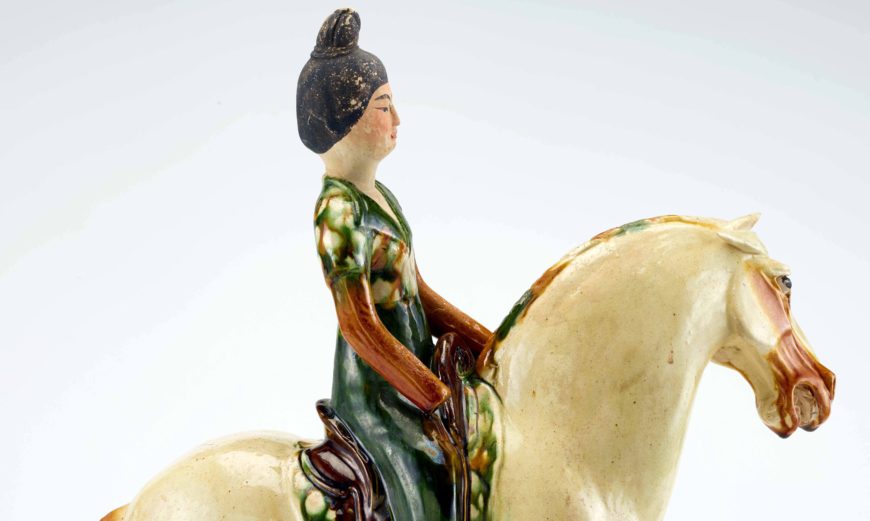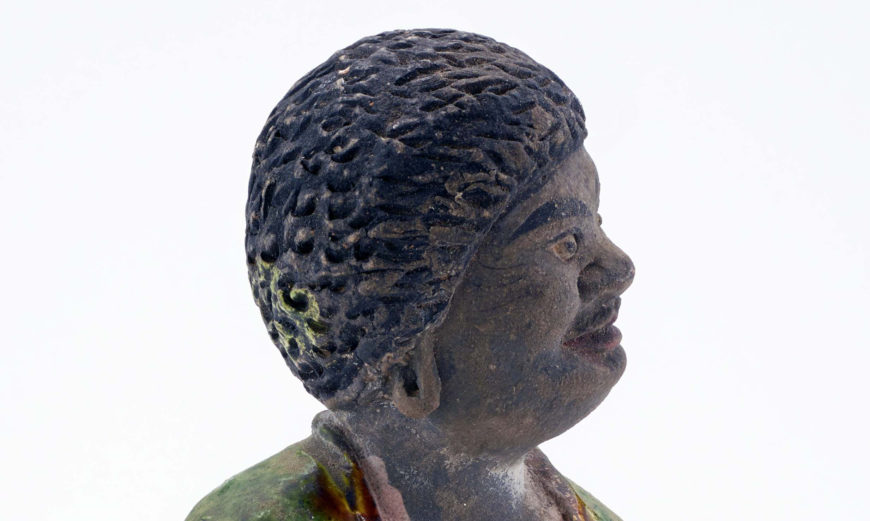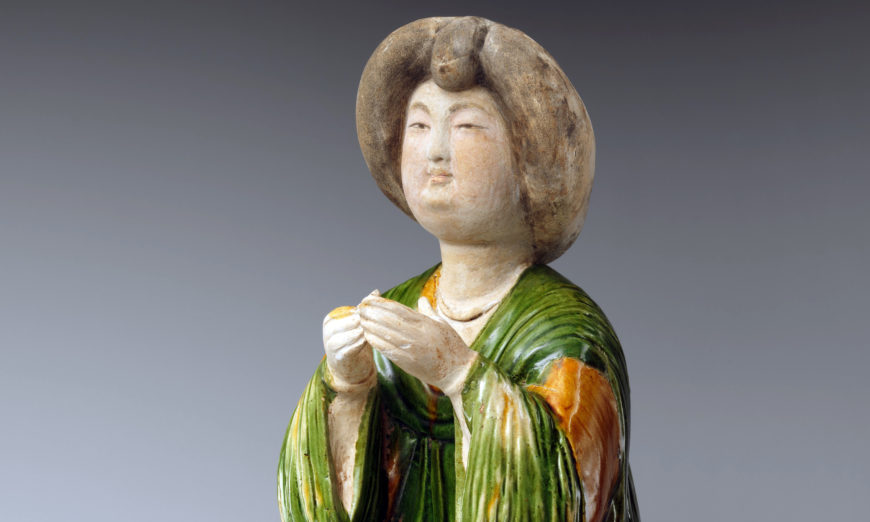Musicians on camels, women on horseback, and terrifying guardians—these are some of the figurines found in Tang dynasty tombs
Polychrome figures (sancai), 618–907 C.E. (Tang dynasty), white clay, lead oxide flux and glazes colored with copper, iron, manganese, and cobalt; fired at 800 degrees Celsius (Shanghai Museum); a conversation between Dr. Kristen Loring Brennan and Dr. Beth Harris.
[0:00] [music]
Dr. Kristen Loring Brennan: [0:00] We are in the Shanghai Museum, looking at a group of figurines from the Tang dynasty.
Dr. Beth Harris: [0:00] The figurines that we’re looking at in this particular case are all female figures.
Dr. Brennan: [0:18] Some of them are standing, some of them are sitting, some of them are holding birds on their hand.
Dr. Harris: [0:28] It’s not just figures that we see during this time, but we also see horses, and camels, and even female figures riding horses. These figures seem so lifelike that we almost get a sense of what life was like in Tang dynasty China.
Dr. Brennan: [0:40] In particular, at the capital of Chang’an. Tang dynasty Chang’an benefited greatly from the Silk Road connections. The Silk Route went right through there. When we say Silk Route, we don’t mean just one road, we mean a network of trade that spanned all the way to the Mediterranean.
Dr. Harris: [0:56] Often, we think about China as a very separate place from Europe, from the Mediterranean, when in fact there were numerous trade routes bringing goods back and forth between what we today call the East and the West.
Dr. Brennan: [1:10] It wasn’t just silk going one way leaving China, going to the Mediterranean, but it was also all of the points along the Silk Road bringing things in. In particular, from Central Asia, musical troupes on camels would be bringing in these Central Asian melodies that contributed to the development of court melodies at the capital in Chang’an.
Dr. Harris: [1:39] And so what we can see is a life at court in Chang’an that wanted luxury goods, not things that could be produced locally only, but things that could be brought that were exotic from far away. We’re talking about a China during the Tang Dynasty that is much more cosmopolitan.
Dr. Brennan: [1:50] Meaning all different kinds of leisure activities, fashions. When we look at these figurines and their dress, we see the variety of different colors and suggestion that they might have been wearing textile patterns, textiles that perhaps benefited from motifs that had come from very far. Hairstyles that are sculpted into a array of different butterfly-shaped formations, moons, and big wisps.
Dr. Harris: [2:20] And one of the figures dressed very differently, perhaps indicating that they’re not Chinese but from Central Asia.
Dr. Brennan: [2:21] You can see the boots, the shorter robe, the shorter sleeves. If this was a court dancer at the capital of Chang’an, we would see long sleeves so that she could dance and show her movement, but here, this appears to be somebody in Central Asian dress.
[2:36] The pose even actually is very interesting. She’s got a parrot on her hand. She also has a very elaborate hairstyle, but seems to be so expressive.
Dr. Harris: [2:45] All of these figures have fabulous hairstyles, so there’s this sense of a concern for fashion.
Dr. Brennan: [2:51] Even the sculptor is really trying to capture what their bodies even looked like.
Dr. Harris: [2:55] Each of these figures, even the ones that are simply standing or sitting, feel alive. They have a sense of animation in their bodies. They tilt their heads slightly. They move their hips slightly. There’s a sense of liveliness, which in some ways feels like a contrast to the idea of where we found them.
[3:12] These were mostly found in tombs. Although, just because we found them in tombs doesn’t mean that they weren’t also found in the court itself. But they survived because they were found in tombs. They’re in tombs because people wanted to bring with them into the afterlife all the pleasures that they enjoyed in their life at court.
Dr. Brennan: [3:31] When they sculpted these kinds of objects — they’re white clay then glazed on top — they portrayed these idealized body types. We have one figurine here who is quite plump, very voluptuous. She’s draped in so much fabric. You can see the folds of her gown. She’s wearing layers and layers of silk.
[3:49] Those plump cheeks was something that we see throughout sculpture, not just of women but also in Buddhist sculpture at the time. Buddhism was flourishing with the patronage of the court.
Dr. Harris: [3:58] There were Buddhist temples all along the Silk Route where traders would stop. The full-figured woman with her arms tucked in her sleeves, one gets the sense not only that that’s the ideal beauty form, but the ideal way of walking, her gracefulness at court.
[0:00] And this brown and green is a particular kind of glazing that’s typical of the Tang Dynasty.
Dr. Brennan: [4:21] This is the three-color glaze, the sancai. That three-color glaze is mineral pigments; we have copper, iron, manganese. Sometimes you’ll also see cobalt, we have some touches of it on the figurines here. But typically, the three colors being that ivory white, that amber/orangish red, and then this vibrant green.
Dr. Harris: [0:00] And in the glaze we frequently see dripping, a sense almost of watercolor.
Dr. Brennan: [4:47] When they started to fire these glazes — they have quite a bit of lead content — when fired, they would drip. What would result are these splashy-looking drips. You’d see the colors pooling together at times.
Dr. Harris: [4:59] We’re really getting an insight into courtly life at Chang’an during the Tang Dynasty here.
[0:00] [music]





